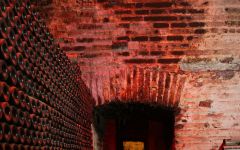Casillero del Diablo Rose 2020



Product Details
Your Rating
Somm Note
Winemaker Notes
Intense strawberry color with bright purple hints. A rich bouquet of sun-kissed red berries and wild raspberries, backed with hints of spice. This rose is packed with fresh and fruity flavors of blackberry and raspberry, backed by a nice backbone of
acidity, and a clean dry finish.
Enjoy with light summer dishes such as grilled tune, cold pasta salads, and fresh cheeses like chevre or mozzarella.







More than 135 years ago, Don Melchor de Concha y Toro was renowned for crafting some of the finest wines in Chile. Reserving for himself an exclusive batch of his best wines, he ignited a rumor that the devil himself was his cellar’s guardian—and in doing so, ensured thieves stayed away from his precious wines. This rumor became a legend that conquered the world, with Casillero del Diablo (“the devil’s cellar”) today recognized as one of the world’s leading wine brands. First released in 1963, Casillero del Diablo is a worldwide standard-bearer for premium quality Chilean wines—and the legend of the Devil’s Cellar lives on at the original Concha y Toro family estate, Chile’s leading tourist destination.
Vineyards for Casillero del Diablo’s celebrated wines hail from Chile’s Central Valley. Located mainly between parallels 30° and 40° south and in close proximity to capital city of Santiago, this internationally known wine region possesses the ideal characteristics for quality grape growing and winemaking. Among the valley's main features are the influence of the Pacific Ocean and the Andes Mountains, perfectly balanced soils and mountain-water rivers. This ideal terroir allows winemakers to craft an appealing variety of wine styles from many unique and increasingly popular sub-regions.

Whether it’s playful and fun or savory and serious, most rosé today is not your grandmother’s White Zinfandel, though that category remains strong. Pink wine has recently become quite trendy, and this time around it’s commonly quite dry. Since the pigment in red wines comes from keeping fermenting juice in contact with the grape skins for an extended period, it follows that a pink wine can be made using just a brief period of skin contact—usually just a couple of days. The resulting color depends on grape variety and winemaking style, ranging from pale salmon to deep magenta.

Dramatic geographic and climatic changes from west to east make Chile an exciting frontier for wines of all styles. Chile’s entire western border is Pacific coastline, its center is composed of warm valleys and on its eastern border, are the soaring Andes Mountains.
Chile’s central valleys, sheltered by the costal ranges, and in some parts climbing the eastern slopes of the Andes, remain relatively warm and dry. The conditions are ideal for producing concentrated, full-bodied, aromatic reds rich in black and red fruits. The eponymous Aconcagua Valley—hot and dry—is home to intense red wines made from Cabernet Sauvignon, Syrah and Merlot.
The Maipo, Rapel, Curicó and Maule Valleys specialize in Cabernet and Bordeaux Blends as well as Carmenère, Chile’s unofficial signature grape.
Chilly breezes from the Antarctic Humboldt Current allow the coastal regions of Casablanca Valley and San Antonio Valley to focus on the cool climate loving varieties, Pinot Noir, Chardonnay and Sauvignon Blanc.
Chile’s Coquimbo region in the far north, containing the Elqui and Limari Valleys, historically focused solely on Pisco production. But here the minimal rainfall, intense sunlight and chilly ocean breezes allow success with Chardonnay and Pinot Noir. The up-and-coming southern regions of Bio Bio and Itata in the south make excellent Riesling, Chardonnay and Pinot Noir.
Spanish settlers, Juan Jufre and Diego Garcia de Cáceres, most likely brought Vitis vinifera (Europe’s wine producing vine species) to the Central Valley of Chile sometime in the 1550s. One fun fact about Chile is that its natural geographical borders have allowed it to avoid phylloxera and as a result, vines are often planted on their own rootstock rather than grafted.
